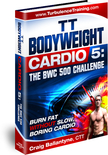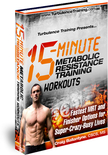How to Add Intensity to Your Workout
 Men’s Fitness magazine recently asked me how to add intensity to a workout to get more results. Since this interview will be dramatically condensed when it finally goes to publication, I wanted to give you the full uncensored workout intensity tips here.
Men’s Fitness magazine recently asked me how to add intensity to a workout to get more results. Since this interview will be dramatically condensed when it finally goes to publication, I wanted to give you the full uncensored workout intensity tips here.
Q: What are the benefits of pushing yourself?
Answer:
The big mistake that most people make is they confuse “going to the gym” with “training”.
People that just “go to the gym” and go through the motions, doing the same workout over and over and over again each week do NOT make progress.
Here’s why – in order to make progress, you must give your body a new training stimulus, and then during your recovery from the training your body adapts to the training stimulus by changing.
It’s like getting a tan. When you go out on the first intensely sunny day in spring, your skin adapts by changing color. But in August, when you already have a tan, if you just go and spend 20 minutes outside, it’s not going to change your skin color…because you’ve already adapted and this is not a new stimulus.
If you wanted to darken your tan, you’d need to spend more time out in the hot sun.
That’s how training works.
It’s easy to go from beginner to relatively fit with the same workout for 8-12 weeks. But if you want to make more advanced changes, you need to ‘rev up’ your workout.
Q: When do you know it’s time to step it up?
Answer:
If you are not improving, but you are going to the gym consistently, eating well, and getting adequate sleep and recovery, then it’s time to step it up if you want better results.
Generally, we’ve found that a workout program should change every 3-6 weeks. The more advanced you are, the more often the program should change.
Q: The physiological benefits to changing things up (whether that’s adding additional weight or training different body parts)
Answer:
Your body can adapt to anything. For example, if you start drinking 3 beers a night every night, at first you might get buzzed quick, but after 10-20 days, it won’t feel the same. You’ll need more booze to get the same buzz.
Likewise, your body adapts to movement and exercise the same way.
So when you change your program, you put new demands and stimuli on the body. The body reacts by changing (either growing muscle, getting stronger, improving aerobic capacity, etc.) so that if you apply the same stimulus again, your body will be better prepared for it.
That’s why if you do the same workout for 8 weeks in a row, what use to get you sore, now no longer causes any muscle soreness at all – your body has adapted.
So…
Adding weight (intensity) to your lifts will help you get stronger
Adding weight and volume (more sets and reps) plus more calories will help you get bigger
Adding sprint intervals will help you increase your aerobic capacity
All of these are ways to boost your results.
Q: What are common mistakes to avoid?
Answer:
We all want results fast, but going too hard, too quickly puts you at risk of injury – both short-term and in the long-term with chronic overuse injury.
More training volume is not the answer in most cases.
Intense training, done in a small amount, works really well for boosting results.
But that requires an adequate warm-up…never skip a warmup and never sacrifice good form. Those are the two biggest reasons for acute injury.
Q: Can you share 5 ways to rev up your workout?
Answer:
You bet.
a) 20-10 Bodyweight Interval Training
NOTE: This is not called “Tabata Training”. Tabata training is a strict protocal where you work at 170% VO2 max. Just because something uses 20 seconds of work and 10 seconds of rest does not make it a “tabata”.
This is a total body workout using bodyweight movements like burpees, jumping jacks, bodyweight squats, etc. You can also use equipment, like in kettlebell swings.
Do as many reps as you can in 20 seconds, rest for 10, and then repeat for 8 rounds.
This will boost your aerobic fitness and muscle endurance.
b) Increase the weight by 5% and decrease your reps per set by 2. This will get you stronger.
For example, let’s say you are bench pressing 200 pounds for 8 reps per set, but you’re stuck. The simplest thing to do is increase your bench press weight to 210 pounds and decrease the reps per set to 6 reps. That’s a new stimulus for strength and even for muscle growth, and it’s a safe place to start.
c) Use the kettlebell swing for improvement in virtually all athletic performance.
The kb swing has the potential to make you more explosive (jump higher) and to increase your stamina in both anaerobic (basketball) and aerobic (10k) events.
The kb swing trains the cardiovascular system and the posterior chain of the body.
Hold a kb in both hands with knees bent and feet slightly wider than hip-width apart. Push your butt back and hike the kettlebell back between your legs. Your torso should bend forward and your hips should move back for balance. Extend your knees and hips to drive the weight forward and up. The hip drive should raise the kb up to chest height. The arms just hold the kb, and don’t do much lifting.
This is NOT a squat motion. Instead, there is just a slight bend in the knees. The low back stay tensed and slightly arched at all times. Do not round the low back.
Do 3 sets of 20 swings in your first workout. Build up to 200 swings done in sets of 20 with 30 seconds of rest between sets.
d) Drop Sets
This is a simple and proven way to add volume for muscle growth. You can use this with almost any bodybuilding type exercise.
Do your regular set – you can even start with the strength boosting set outlined earlier. Go 1 rep short of failure.
Then immediately decrease the weight by 20% and complete another set going 1 rep short of failure.
Finally, decrease the weight by 20% one more time and complete a final set going to muscle failure – with proper form.
Take 1 minute rest and repeat 2 more times.
Do this at the end of your workout because you’re muscles will be fully fatigued at this time. No more lifting. Instead, go straight to the nutrition bar and get some protein and carbohydrates for growth and recovery.
e) Superset your workouts for metabolic resistance training benefits
When you use non-competing supersets, you can cut down on your workout time and increase your calorie burning results.
You will pair two exercises back to back that do not interfere with one another. For example, a squat and a pulllup are non-competing. As are a db chest press and a db reverse lunge.
Do the first exercise for 8 reps going one repetition short of failure. Then without rest, move to the other exercise for 8 reps going one repetition short of failure. Rest 30-60 seconds and repeat 2 more times.
Choose 3 non-competing supersets for a total body metabolic resistance training workout. (Use the above two examples plus KB swings combined with pushups – 20 reps each – as the 3rd superset.)
You’ll burn fat faster than ever before with this MRT system that is the basis for all Turbulence Training fat burning success stories.
Try these intense 20-10 bodyweight and MRT workouts here
Craig Ballantyne, CTT
Certified Turbulence Trainer